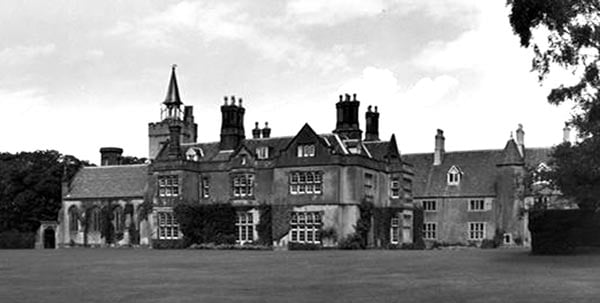Grace Dieu Manor lies east of Ashby de la Zouch, deep in the Leicestershire countryside. It received its name from a neighbouring priory of Augustinian sisters that was dissolved during the Reformation. The ruins are about a half-mile from the manor. Wordsworth’s Ode to Grace Dieu refers to these ruins. The nearest villages are some miles distant: Whitwick, Thringston, Shepshed, Osgathorpe, Coalville.

Ambrose Phillipps sought to establish himself in Grace Dieu Manor as the patron of a Mass-centre from which priests would go out to convert the locality. To staff this mission Ambrose first approached the Passionists but without success. He then turned to the Rosminians who sent Father Gentili in June 1840. Father Gentili withdrew in May 1842 because of Ambrose’s interference in the mission. Negotiations were opened with the Oblates. Ambrose heard of the Oblates from Bishop de Forbin-Janson, who was a friend of Laura his wife and made a visit to Grace Dieu. Fr. Daly visited Grace Dieu in April and August 1845 to make arrangements for the mission, staying at St. Bernard’s Abbey.
On 5 September 1845 the community took possession of The Warren, a house placed at their disposal by Phillipps, some distance from the Manor House. It afforded the Fathers the privacy needed for their community life but was too far from the villages they served, and Ambrose agreed to build a new residence adjoining the Holy Cross chapel in Whitwick. The Oblates left ‘The Warren’ on 3 July 1847 and were lodged in a house in Thringstone pending completion of the house in Whitwick.
The first members of the community were Fr. Perron, superior, Fr. Naughten, Br. Bayeul, and a secular priest from Marseilles the Abbé Coussinier. Frs. Cooke and Tamburini, with John Noble not yet ordained priest, joining the community in July 1846. Fr. Walsh arrived from Penzance in 1847 and was transferred to Everingham with Fr. Perron. Fr Cooke became superior in November 1847 when Fr. Perron left for Everingham.
The Oblate mission was to serve the manor of Grace Dieu itself and also the village of Whitwick. The Manor itself is a large country house with a chapel attached. It was built for Ambrose Phillipps by his father on the occasion of his marriage to Laura Clifford. The architect was William Railton and he built the stucco house in rectangular plan. Augustus Welby Pugin enlarged the house in his contrasting Gothic style. “To the left, the porch tower was elaborated in its upper levels by Pugin with a clock face, battlements and spirelet and beyond it the nave of the chapel extended to accommodate the public in 1837. To the right Pugin added the extensive two-storey service range with attics in 1847 (paid for by Phillipp’s father) for the expanding family, and rearranged the service side of the house with a kitchen with a steep pitched roof, now internally subdivided and its lantern removed.” The chapel was built in three phases: “the first part in 1834 (which became the chancel), the second the current nave, in 1837, and the third, the north aisle, in 1848-9.” Fr. Perron officiated in the chapel for the first time on 14 September 1845. Pugin also added a separate wing to the manor for the chaplain in 1848 when the Oblates left. Liturgical reformers in the 1960’s stripped the chapel of much of its ornamentation. The manor house is now a Catholic school, owned by the Rosminians.
Fathers Cooke and Noble extended their apostolate to the villages of Thringstone and Osgathorpe and the larger towns, Coalville, Castle Donnington and Ashby de la Zouch. There were many conversions, as witnessed by Bishop Walsh’s confirmation of 232 people at Whitwick in May 1847.
Fr Cooke has left us an extended deion of his ministry and that of Fr Noble. He adopted the pastoral technique of his Rosminian predecessor Fr. Gentili: house visitation and open-air preaching The Fathers would announce that a sermon would be preached on the village-green and a cordial invitation to be present was extended to the inhabitants. The subject of the discourse usually concerned some Christian truth, salvation, conversion, the passion and death of Christ. The most controversial topics were avoided.
Departure
When Fr. Perron died in Everingham on 22 February 1848, Fr. Cooke was needed to take his place. Meanwhile too Ambrose Phillipps was beginning to make demands that the Oblates thought were unacceptable. By a decision of the General Council, March 24th, 1848, it was decided to withdraw the community from Grace Dieu and join it with that of Everingham. Good relations were maintained with the family. Fr. Cooke visited Grace Dieu many times later on and during Bishop de Mazenod’s visit to England in 1850 he and Fr. Noble dined with the Phillipps family in Loughborough and stayed overnight, saying Mass next morning.
In a letter dated 18 July 1882 to the then Oblate Provincial Fr A. Gaughran, Laura de Lisle wrote of Fr. Cooke: “a man whom I have always venerated as a saint …There are few things I have ever regretted more than his [Fr. Cooke] leaving this neighbourhood, where his memory is still venerated, for all looked upon him as a Saint. It is about 34 years since he left… In the house where Father Cooke and his companions lived at Whitwick there is a little community of Sisters of Charity of St. Paul, who teach the two schools, and the Priest lives in another house on the opposite side of the road. But there is no longer the quantity of conversions as in the days of Father Cooke.” On 16 June 1892 Laura de Lisle wrote to the Editor of the Oblate Missionary Record from Onebarrow, Leicester: “I have always had the highest esteem for your Order, and I was extremely sorry when the Fathers left our missions. It was a very great loss, for they were truly zealous men, and most successful missionaries.”
Michael Hughes, o.m.i.
